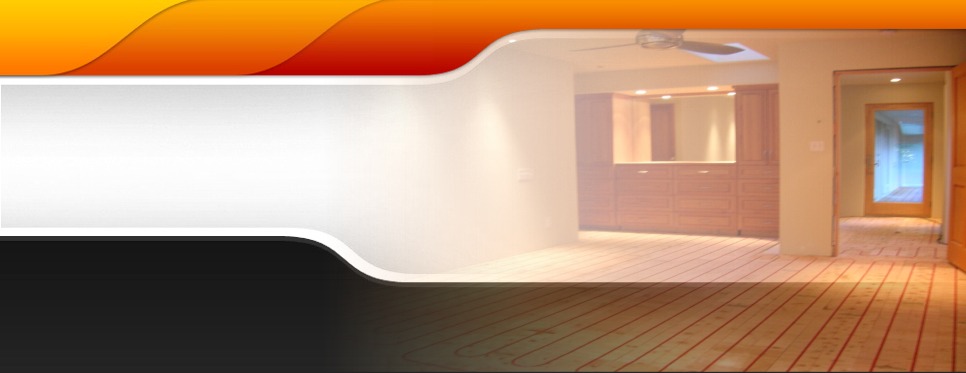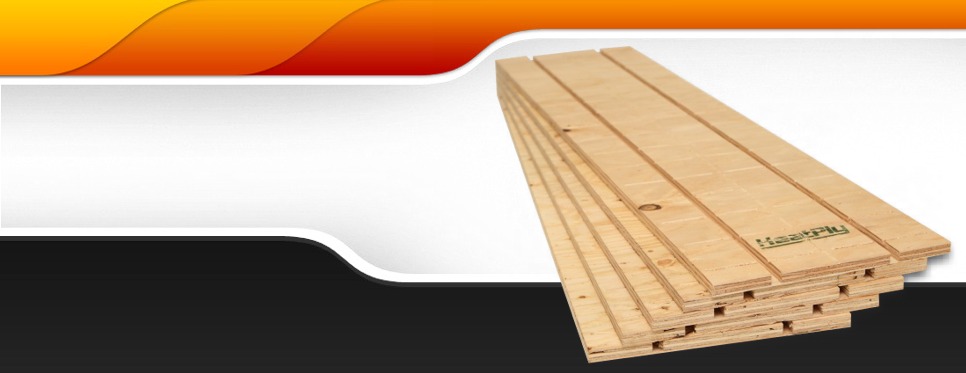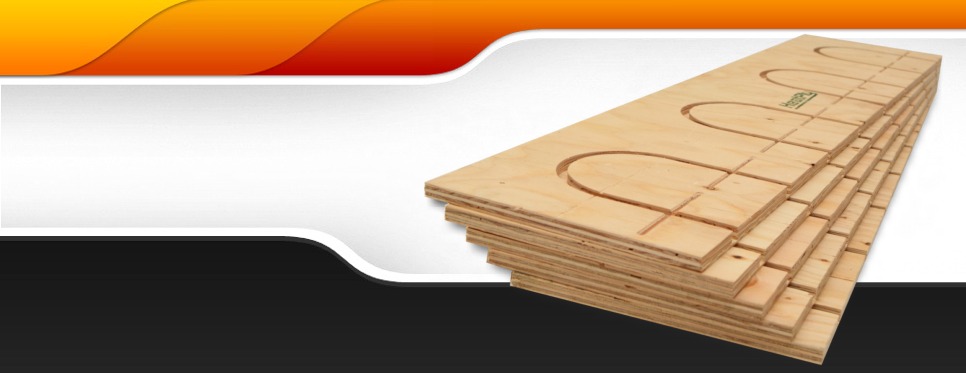
What is radiant floor heating?
Tired of adjusting a thermostat that is always too high or to low? Then you may be ready to find out for yourself that radiant floor heating is the most comfortable home heating system. Not only will you no longer be constantly adjusting a thermostat that does not keep everyone in the house at a temperature they want, you will find a vast reduction in the allergens that circulate in your home due to forced air heating. Radiant floor heating is cost effective, great for the environment, and does not create the noise generated by forced air furnace systems.
Radiant floor heating is a comfortable and efficient form of heating where warm water circulates through flexible, specially designed tubing (PEX) installed within the floor. The heat radiates evenly up through the floor warming the room while providing more comfort for less money.
A radiant system that uses in floor tubing will provide evenly distributed heat throughout any room. It can also be precisely controlled on a room-by-room basis, allowing individuals to reduce the amount of energy they use to heat their home.
How does radiant heat work?
Radiant heat is more efficient and operates cleaner than any other heating system. This is accomplished because water is preheated before flowing into tubing that runs underneath your floor. The water warms the floor, and the heat rises into your living space naturally to create a comfortable atmosphere. This is another energy efficient attribute of radiant heat. HeatPly radiant floor heating systems expand on this simple idea by utilizing the properties of convection to evenly distribute heat across the entire surface of your floor. Our patented in-floor heating panels create consistent, reliable energy efficient heat that outperforms every other heating system on the market. We designed our plywood panels so the tube spacing is closer together than any other radiant heating system built today. This increased water volume serves two purposes: It operates at a lower temperature while conducting heat faster. Indeed, HeatPly is the most effective and efficient way to heat your home or office.
Why choose radiant heat?
You may be wondering about the many advantages of a radiant heat system. Most homes built in the last 30 years feature forced-air heating systems, where a furnace heats air that is pushed through air ducts into various outlets throughout the home. What follows are just some of the benefits you will experience with a radiant heat system in your home or office.
Unmatched Energy Efficiency - With forced air units there is a great deal of energy loss as the air travels through ducts. The further a vent is from the furnace, the more energy will be lost. Any air leakage within the duct will also cause energy loss, and when was the last time you inspected your heating ducts?
Control How Your Home is Heated - Forced air heats your home unevenly. Rooms closer to your thermostat will be warmer than other rooms, and sometimes certain parts of a single room may be colder than other parts.
Health Considerations - Have you ever peeked inside an air duct? During the summer months, when your heating system is offline, these ducts sit idle, with little to no airflow. During this time, black mold, fungus, mildew, bacteria, insects, parasites, and even dead animals can hide inside of your ducts. When you turn on your heater for the first time, all of the air must travel this gauntlet of harmful pathogens until it enters into every nook and cranny of your home.
Comfort - This is the Number One reason so many people have switched over to radiant floor heating. If you have the chance, find a friend who has a radiant floor heating system and ask them how it makes them feel. That conversation alone will do far more to convince you about radiant heating's unparalleled comfort than anything we can say here.
Price - While radiant heat has a higher initial cost than traditional modes of heating (even though our products are some of the most affordable on the market), the money you will save on energy costs will more than pay for the difference many times over, throughout the life of your home. On average, radiant heat costs 30% less to operate than traditional heating, so treat yourself to comfort while taking the strain off of your household budget.
Is radiant heating a new invention?
Radiant heating has been around for over two thousand years. The Romans first used radiant floor heating (with hot water & steam) in their Hypocausts.
Radiant heat originated in ancient times as the system of comfort, and in recent times, floor heating has become increasingly popular as a full and independent heating system. This was made possible by the advent of plastic pipes, the development of control systems and automation of temperature control, wide application of heat sources to renewable resources.
Radiant Floor Heating today is a complete heating system, fully replacing traditional heating systems.
Do HeatPly panels use an aluminum surface?
HeatPly testing has determined the cost to benefit ratio does not justify the use of aluminum. HeatPly convective channels have proven to effectively transfer heat at no added cost. Combined with both convection and conduction, heat is moved across air channels to help distribute warmth evenly in the floor while at the same time the mass of the floor is heated through conduction. Our goal at HeatPly has always been to deliver the most cost effective, efficient, and user friendly products on the market.
How do I install Radiant heat underlayment Panels?
There are many different ways to install radiant heating panels. HeatPly panels are designed with a pre-scribed centerline cutting grid to make your cutting fast and easy. Start by calculating circuit and footage requirements for each zone. Next layout panels working from the manifold location until the panels are layed out throughout the rooms. Panels are then secured to the floor. Hydronic tubing can now be inserted into the panels for connection to the corresponding manifold. We recommend leaving the system pressurized for a 24hr period to check for leak-down before applying finished flooring.
Note: This is an overview of the installation process. Please refer to our instruction manual for your installations. The manual contains critical specifications that must be followed such as circuit and tubing linear footage requirements.
HeatPly provides a step by step installation manual on how to install our radiant heating underlayment panels. A PDF download can be found on the installation page of our website or here: Installation Manual
HeatPly should be installed above subfloor or concrete only. Do not use HeatPly panels over existing vinyl flooring with heavy cushioning or thick foam backing.
Our manual contains important instructions that must be followed during installation. Before installing HeatPly panels read through, understand, and follow all cautionary markings and instructions in our manual.
Can I control the climates in each room separately?
Radiant Floor Heating Systems can be installed with as many or few separate heat zones as you wish. The general recommendation is to establish separate heat zones for each room in the house or building, each controlled with a separate controllable thermostat with in a giving zone. This is an easy to do and common practice for radiant heating contractors. Setting up a heating system with individual zones allows for only heating the parts of the home or building that is being used or occupied making radiant floor heating systems energy efficient and cost effective as compared to traditional heating systems.
How quickly will a Radiant Heating system heat up?
Initial heating of Radiant Heating Systems can vary widely depending on the type of system. HeatPly In Floor Radiant Systems respond quickly as compared to concrete or under-floor systems. Concrete systems can take up to a day to reach temperature as the concrete is such a large thermal mass. Under-floor systems are quicker than concrete but since the tubing is suspended within the floor joists, these systems are inefficient and require higher operating temperatures. HeatPly in floor systems have a low mass and are mounted directly to the floor which results in a system that is more efficient and more responsive.
Radiant Heat and air conditioning?
HeatPly Radiant Floor Heating is perfectly suited to modern heatpump technology providing both heating and cooling systems.
Can the floor get too hot?
No. A properly designed radiant floor heating system will be comfortable even with bare feet. The floor will provide a warmth that is a pleasure to walk on. Radiant heating systems warm the floor and the objects in contact with the floor too. So a consistent, even and quiet heating is distributed throughout the entire floor. Radiant floor heating successfully takes the chill out of cold tile, marble and wood floors and makes the place comfortable.
How is Radiant Heat different from traditional systems?
Forced air heating systems use an energy source to heat air. This heated air is then blown into the rooms of the home through ducting. People in the home feel “warmth” when they come into contact with the heated air. Radiant heat uses a heat source to supply heat directly to your floor through the flow of heated water circulated under the floor. It does not blow dust or allergens through the air. Radiant heat generates invisible infrared radiant energy that simply radiates up from the floor which then heats objects in the room. Objects in the room, as well as the people are heated (or feel “warmth”) when the radiating heat comes into contact with those objects.
How long will the tubing PEX last?
PEX tubing will last as long as the structure it's installed in. PEX tubing has been in use for over twenty years in Europe and life cycle testing has demonstrated that PEX can last in excess of seventy years. PEX is an inert material, virtually indestructible by common elements.
Do I need an oxygen diffusion barrier?
An oxygen diffusion barrier is a special coating applied to the tubing. Barrier PEX is used for radiant heating applications, such as radiant floor heating, in floor heaters, baseboards, radiator systems and boiler supply lines. Barrier PEX features an Oxygen Diffusion Barrier, this helps to prevent oxygen from entering the water throught the wall of the tubing which may corrode cast iron parts in the heating systems. An oxygen diffusion barrier PEX tubing is required for use in HeatPly Radiant Heating Panel Systems. Non barrier tubing is only suitable for potable domestic water piping.
How will my finish flooring affect performance?
Stone, tile, wood, and vinyl are fairly good conductors of heat and do not present any special design considerations. Carpeting may require more temperature from below to allow the heat through. HeatPly Panels have been designed with the tightest tube spacing in the industry allowing them to deliver heat in a very wide range of temperature applications.
Is Radiant Heat more comfortable?
Unlike traditional heating systems that just warm the air, radiant heating warms the floor and the objects in the room. The entire floor distributes a consistent, even, and quiet heat. There are NO drafts and radiant floor heating takes the chill out of cold tile, marble, and wood floors.
We are happy to answer any questions that you may have for your purchase. Our staff can provide guidance in calculating requirements, room layouts, circuit requirements, etc. Quotes are available upon request.



